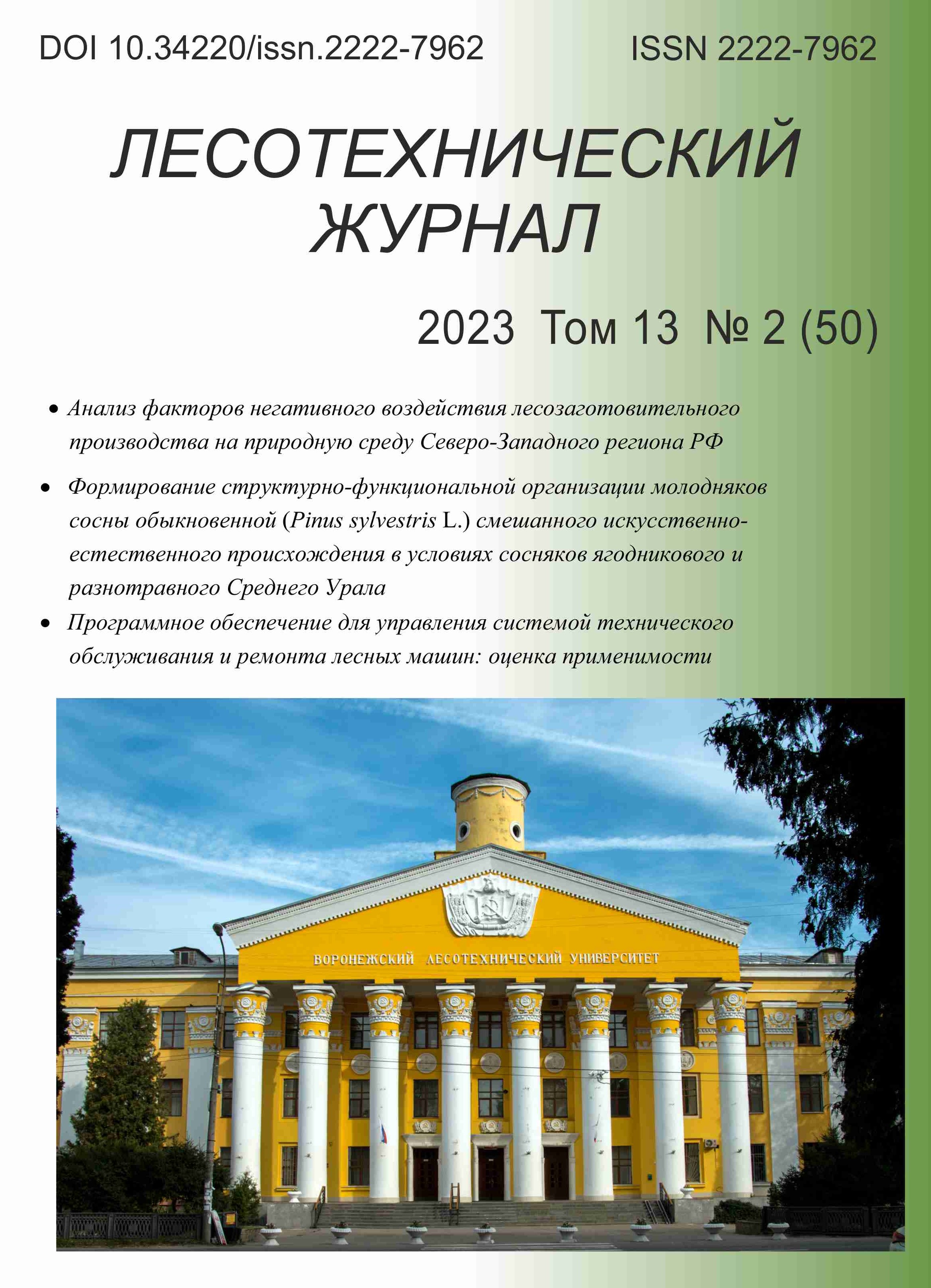630
68.47
When enterprises of the timber industry complex form protective forest plantations along linear infrastructure facilities, the problem of subsequent spontaneous reproduction of tree and shrub vegetation arises, which leads to disorder in the territories of the above facilities and creates a threat to the safety of their operation. In many foreign countries, work to maintain the territories of linear infrastructure facilities in a standard state is carried out in strict accordance with certain methods of conceptual management of vegetation growth. At the same time, such management methods are practically unknown both to the domestic scientific community dealing with the issues of protective afforestation, and to those who make decisions on the need to influence unwanted trees and shrubs. The purpose of the study was to study and analyze systemic methods for managing unwanted tree and shrub vegetation growing on the territories of linear infrastructure facilities in order to improve the quality and efficiency of its removal, as well as to make recommendations for the proper maintenance of these territories. Cluster analysis of world research trends in forest vegetation management revealed 3 major areas associated with: a decrease or increase in species richness and diversity of vegetation, as well as the inadmissibility of its subsequent renewal; methods and means of influencing vegetation, including the benefits of vegetation management; ecological and aesthetic consequences of vegetation management, as well as public perception of the results of such management. The established principles for the application of the integrated vegetation management system (Integrated Vegetation Management: IVM), which is widespread in the world, are necessarily taken into account by organizations responsible for managing various protected zones and right-of-way. The most convenient for characterizing a selective approach to the management of unwanted vegetation growing in the territories of linear infrastructure facilities is the phrase «Integrated forest vegetation management». As the basic structure of the IVM system, the model proposed in 2005 by Nowak and Ballard is used, which provides for the implementation of a complete systems approach when influencing vegetation. It is inappropriate to combine in one step (the critical phase of this model) the monitoring of the potential effect of the impact on unwanted vegetation and the assessment of this impact. With further improvement of the IVM system, it is necessary to create a set of clearly defined and at the same time measurable indicators that fully reflect the achieved (or not achieved) effect from the impact on unwanted vegetation. It is shown that in order to introduce protective afforestation into domestic practice, IVM systems should not be a separate vegetation management tool, but a combination of management approaches, including not only the assessment of a plot of a linear infrastructure facility, but also subsequent control and determination of the quality of the normative maintenance of this plot.
infrastructure facility, vegetation, removal, integrated management, systems approach, quality, monitoring
1. Arenas J., Escudero A., Mola I., Casado M. Roadsides: An opportunity for biodiversity conservation. Applied Vegetation Science. 2017;20(4):527. DOI: https://doi.org/10.1111/avsc.12328
2. Barker A., Prostak R. Management of Vegetation by Alternative Practices in Fields and Roadsides. International Journal of Agronomy. 2014;1:1-12. DOI: https://doi.org/10.1155/2014/207828.
3. Bernes C., Bullock J.M., Jakobsson S. et al. How are biodiversity and dispersal of species affected by the management of roadsides? A systematic map. Environmental Evidence, 2017;6(1):24. DOI: https://doi.org/10.1186/s13750-017-0103-1
4. Byrd J., Maddox V., Russell D. Right of Way Integrated Vegetation Management: Essential to Keep the Us Economy Moving. Outlooks on Pest Management. 2020;31(5):201. DOI: https://doi.org/10.1564/v31_oct_02
5. Camarretta N., Harrison P.A., Bailey T. et al. Monitoring forest structure to guide adaptive management of forest restoration: a review of remote sensing approaches. New Forests. 2019;51(4):573. DOI: https://doi.org/10.1007/s11056-019-09754-5 EDN: https://elibrary.ru/JJCRWP
6. DiFalco S., Morzillo A.T. Comparison of Attitudes towards Roadside Vegetation Management across an Exurban Landscape. Land. 2021;10(3):308. DOI: https://doi.org/10.3390/land10030308
7. DiFalco S., Morzillo A.T., Ghosh D. Interpolating resident attitudes toward exurban roadside forest management. Landscape Ecology. 2022;1:16. DOI: https://doi.org/10.21203/rs.3.rs-1310544/v1
8. Fassnacht F.E., Latifi H., Stereńczak K. et al. Review of studies on tree species classification from remotely sensed data. Remote Sensing of Environment. 2016;186:64. DOI: https://doi.org/10.1016/j.rse.2016.08.013 EDN: https://elibrary.ru/WSTMWL
9. Fore S.R., Hill M.J. Modeling the potential natural vegetation of Minnesota. Ecological Informatics. 2017;41:116. DOI: https://doi.org/10.1016/j.ecoinf.2017.07.006
10. Gao L., Wang X., Johnson B.A. et al. Remote sensing algorithms for estimation of fractional vegetation cover using pure vegetation index values: A review. ISPRS Journal of Photogrammetry and Remote Sensing. 2020;159:364-377. DOI: https://doi.org/10.1016/j.isprsjprs.2019.11.018 EDN: https://elibrary.ru/SOMHHU
11. García P., Sanna M., Fernández García M. et al. Monitoring invasive alien plants dynamics: application in restored areas. Biologia. 2023;78(3):112. DOI: https://doi.org/10.1007/s11756-023-01375-w
12. Gonsamo A., D'odorico P., Pellikka P. Measuring fractional forest canopy element cover and openness - definitions and methodologies revisited. Oikos. 2013;122(9):1283. DOI: https://doi.org/10.1111/j.1600-0706.2013.00369.x
13. Hale D., Morzillo A. Landscape characteristics and social factors influencing attitudes toward roadside vegetation management. Landscape Ecology. 2020;35(9): 2029. DOI: https://doi.org/10.1007/s10980-020-01078-6 EDN: https://elibrary.ru/TUAPDJ
14. Hashad K., Yang B., Gallagher J. et al. Impact of roadside conifers vegetation growth on air pollution mitigation. Landscape and Urban Planning. 2023;229:104594. DOI: https://doi.org/10.1016/j.landurbplan.2022.104594. EDN: https://elibrary.ru/XZWXIM
15. Henderson D., Smith J., Fitch G. Impact of Vegetation Management on Vegetated Roadsides and Their Performance as a Low-Impact Development Practice for Linear Transportation Infrastructure. Transportation Research Record: Journal of the Transportation Research Board. 2016;2588(1):172. DOI: https://doi.org/10.3141/2588-19
16. He W., Xu X., Zhang C. et al. Understory vegetation removal reduces the incidence of non-additive mass loss during leaf litter decomposition in a subtropical Pinus massoniana plantation. Plant and Soil. 2020;446(1-2):529. DOI: https://doi.org/10.1007/s11104-019-04378-2 EDN: https://elibrary.ru/XQDSAD
17. Jumain M., Ibrahim Z., Ismail Z. et al. Influence of riparian vegetation on flow resistance in mobile bed straight compound channels. Journal of Physics: Conf. Ser. 2017;1049:012027. DOI: https://doi.org/10.1088/1742-6596/1049/1/012027
18. Kattenborn T., Lopatin J., Förster M. et al. UAV data as alternative to field sampling to map woody invasive species based on combined Sentinel-1 and Sentinel-2 data. Remote Sensing of Environment. 2019;227:61. DOI: https://doi.org/10.1016/j.rse.2019.03.025 EDN: https://elibrary.ru/MNRCUN
19. Kloster D.P., Morzillo A.T., Butler B.J. et al. Amenities, disamenities, and decision-making in the residential forest: An application of the means-end chain theory to roadside trees. Urban Forestry. 2021;65:127348. DOI: https://doi.org/10.1016/j.ufug.2021.127348.
20. Lampinen J., Anttila N. Reconciling road verge management with grassland conservation is met with positive attitudes among stakeholders, but faces implementation barriers related to resources and valuation. Journal of Environmental Planning and Management. 2020;64:1. DOI: https://doi.org/10.1080/09640568.2020.1785405
21. Leston L., Koper N. An urban wildlife habitat experiment: conservation implications of altering management regimes on animals and plants along urban and rural rights-of-way. Journal of Urban Ecology. 2019;5(1):1. DOI: https://doi.org/10.1093/jue/juz013
22. Lynch A.J., Thompson L.M., Morton J.M. ed al. RAD Adaptive Management for Transforming Ecosystems. BioScience. 2022;72(1):45. DOI: https://doi.org/10.1093/biosci/biab091
23. Mácová K., Szórádová A., Kolařík J. Are Trees Planted along the Roads Sustainable? A Large-Scale Study in the Czech Republic. Sustainability. 2022;14(9):5026. DOI: https://doi.org/10.3390/su14095026 EDN: https://elibrary.ru/EGTUTE
24. Mahan C., Ross B., Yahner R. The Effects of Integrated Vegetation Management on Richness of Native Compatible Flowering Plants and abundance of Noncompatible Tree Species on a Right-of-Way in Central Pennsylvania, USA. Arboriculture & Urban Forestry. 2020;46(6): 395. DOI: https://doi.org/10.48044/jauf.2020.029
25. Marche B., Camargo M., Bautista S. ed al. Qualitative sustainability assessment of road verge management in France: An approach from causal diagrams to seize the importance of impact pathways. Environmental Impact Assessment Review. 2022;97(6). DOI: 106911. DOI: https://doi.org/10.1016/j.eiar.2022.106911
26. Martin A., Schuler J.L., Edwards J. Vegetation response to strip cutting young hardwood stands in West Virginia. Journal of Sustainable Forestry. 2017;36(2):58. DOI: https://doi.org/10.1080/10549811.2017.1373254
27. Mavrommatis A., Christodoulou G. Velocity Distribution in Channels with Submerged Vegetation. Fluids. 2022;7(9):290. DOI: https://doi.org/10.3390/fluids7090290 EDN: https://elibrary.ru/OMEJLA
28. McFalls J., Storey B., Das S. Long-Term Vegetation Management Strategies for Roadsides and Roadside Appurtenances. Washington, National Academies Press, 2023, 121 r. DOI: https://doi.org/10.17226/26876
29. Nejatian A., Makian M., Gheibi M., Fathollahi-Fard A.M. A novel viewpoint to the green city concept based on vegetation area changes and contributions to healthy days: a case study of Mashhad. Environmental Science and Pollution Research. 2022;29(1):702-710. DOI: https://doi.org/10.1007/s11356-021-15552-4 EDN: https://elibrary.ru/NHJQTZ
30. Nemec K., Stephenson A.L., Losch M. How Engineers and Roadside Vegetation Managers Maintain Roadside Vegetation in Iowa, USA. Environmental Management. 2022;70:593-604. DOI: https://doi.org/10.1007/s00267-022-01683-y EDN: https://elibrary.ru/DREHXI
31. Phillips B., Bullock J., Osborne J., Gaston K. Ecosystem service provision by road verges. Journal of Applied Ecology. 2019;57(3):488. DOI: https://doi.org/10.1111/1365-2664.13556 EDN: https://elibrary.ru/LRYWDQ
32. Russell K., Russell G., Kaplan K. ed al. Increasing the conservation value of powerline corridors for wild bees through vegetation management: an experimental approach. Biodiversity and Conservation. 2018;27(12):2541. DOI: https://doi.org/10.1007/s10531-018-1552-8
33. Somodi I., Ewald J., Bede-Fazekas A., Molnár Z. The relevance of the concept of potential natural vegetation in the Anthropocene. Plant Ecology and Diversity. 2021;14(1):13. DOI: https://doi.org/10.1080/17550874.2021.1984600
34. Sterner S., Aslan C., Best R. Forest management effects on vegetation regeneration after a high severity wildfire: A case study in the southern Cascade range. Forest Ecology and Management. 2022;520(4):120394. DOI: https://doi.org/10.1016/j.foreco.2022.120394. EDN: https://elibrary.ru/CNMOCO
35. Suttle R., Kane B., Bloniarz D. Comparing the Structure, Function, Value, and Risk of Managed and Unmanaged Trees along Rights-of-Way and Streets in Massachusetts. Forests. 2022;13:1602. DOI: https://doi.org/10.3390/f13101602. EDN: https://elibrary.ru/PPMVBI
36. Tanner A.L., Leroux S.J. Effect of Roadside Vegetation Cutting on Moose Browsing. PLoS ONE. 2015;10(8):0133155. DOI: https://doi.org/10.1371/journal.pone.0133155
37. Taylor W.O., Watson P.L., Cerrai D. et al. Dynamic modeling of the effects of vegetation management on weather-related power outages, Electric Power Systems Research. 2022;207:107840. DOI: https://doi.org/10.1016/j.epsr.2022.107840. EDN: https://elibrary.ru/FWHQUN
38. Totino M., Urdampilleta C.M., Ithuralde R.E. et al. A methodological approach for the analysis of ecosystem services from the local communities’ perspective. Ambio. 2023;52:786-801. DOI: https://doi.org/10.1007/s13280-022-01807-y.
39. Wiens J., Zedler J., Rush V.H. et al. Facilitating Adaptive Management in California’s Sacramento-San Joaquin Delta. San Francisco Estuary and Watershed Science. 2017;15(2):1-15. DOI: https://doi.org/10.15447/sfews.2017v15iss2art3.
40. Willmert H., Osso J., Twiss M. Winter road management effects on roadside soil and vegetation along a mountain pass in the Adirondack Park. Journal of Environmental Management. 2018;225:215-223. DOI: https://doi.org/10.1016/j.jenvman.2018.07.085.
41. Yang Y., Zhu Q., Peng C. et al. A novel approach for modelling vegetation distributions and analysing vegetation sensitivity through trait-climate relationships in China. Scientific Reports. 2016;6:24110. DOI: https://doi.org/10.1038/srep24110. EDN: https://elibrary.ru/WPHAMD
42. Zhao C., Yang Y., Hu Y. Methodology, assessment and application of biotope mapping for urban parks in China: A case study on Riverside Park, Yichang. Frontiers in Environmental Science. 2022;10(8):362. DOI: https://doi.org/10.3389/fenvs.2022.1008362.












